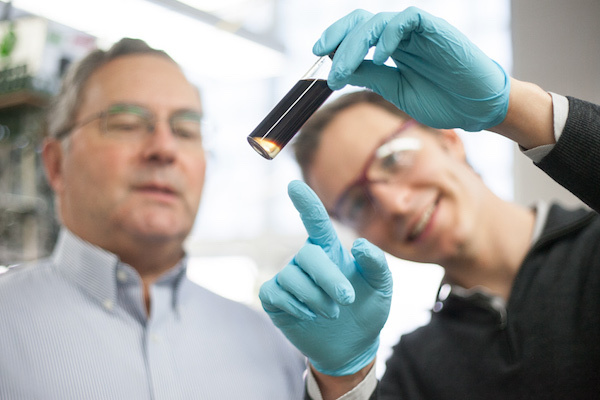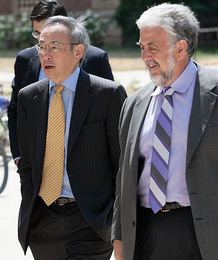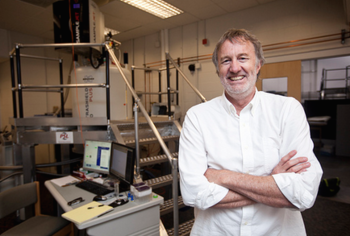Bioenergy center’s research leads to 100th patent application

GLBRC researcher and engineering Professor Jim Dumesic (left) and former postdoctoral researcher Jeremy Luterbacher. Research in the Dumesic lab focuses on chemical engineering approaches to biomass conversion.
Photos courtesy of GLBRC
The Great Lakes Bioenergy Research Center (GLBRC), one of three bioenergy research centers established in 2007 by the U.S. Department of Energy (DOE), recently celebrated the filing of its 100th patent application.
Led by the University of Wisconsin–Madison and major partner Michigan State University, GLBRC consists of more than 400 scientists, students and staff working to develop a robust and sustainable pipeline for producing biofuels and chemicals from the nonedible, or cellulosic, portion of plants. Each year the center brings in about $25 million in federal funding.
Since 2011, the center has reported 50 percent more inventions than expected for a university entity of its size and funding level. Its research has spurred startup companies and supports a range of industries: energy, automotive, and biochemical among them.

Tim Donohue hosting then-Energy Secretary Steven Chu on a tour of GLBRC.
“Collaboration is the center’s lifeblood,” GLBRC director Tim Donohue says. “Across different research areas — sustainability, plants, deconstruction and conversion — GLBRC scientists are working with and learning from each other every single day. Our relationship with industry, government and other research institutions helps us produce knowledge that meets real-world needs. By spurring the development of cellulosic biorefineries that will produce the fuels and chemicals we need and use, we are driving the economy and addressing a critical societal need.”
Candace Wheeler, technical fellow at the General Motors Research and Development Center, says research from the DOE’s Bioenergy Research Centers is helping to meet the diverse energy needs of a growing fleet of GM vehicles.
“We look to Bioenergy Research Center researchers for new knowledge and scientific discoveries that will support the sustainable production of biofuels,” Wheeler says.
In recently developed GLBRC technology, UW–Madison’s John Ralph, Michigan State’s Curtis Wilkerson and the University of British Columbia’s Shawn Mansfield pooled their diverse expertise to engineer poplar trees whose plant walls contain a modified form of the polymer lignin to make them easier to degrade for conversion to fuel. The resulting technology, reported in Science last April, is of broad interest to the bioenergy, bioproducts and fiber industries.

John Ralph’s research is of broad interest to the bioenergy, bioproducts and fiber industries.
“GLBRC is at the forefront of new concepts for lignin utilization,” says Jerry Gargulak, Business Development Manager at LignoTech USA. “The work being done to design modified poplar lignin with decreased complexity is spectacular. This technology has the potential to open up a completely new route to lignin-based chemicals and change the bio-based chemical industry in a new and exciting way.”
GLBRC technology has also laid the foundation for several startup companies. Hyrax Energy, a private company begun by UW–Madison researcher Ronald Raines, was the first company to emerge. Its technology converts biomass into fermentable sugars usable in biochemicals, bioproducts and drop-in fuels.
GlucanBio, which draws from technologies developed by GLBRC’s Jim Dumesic, focuses on de-risking and scaling up the use of a plant-derived solvent capable of dramatically reducing the cost of producing biofuels and bioproducts.

Ronald Raines
“What we’re seeing is that collaborative partnerships like GLBRC’s greatly increase the potential for transformative research and technology transfer,” Donohue says.
Several technology transfer organizations, including the Wisconsin Alumni Research Foundation, Michigan State University’s MSU Technologies and Texas A&M’s Office of Technology Commercialization, support the center’s intellectual property efforts and enable the licensing of its technologies.
The 100th patent “is an exciting milestone for GLBRC,” says Leigh Cagan, chief technology commercialization officer for WARF. “We’re proud to support the UW–Madison researchers and partners working to meet the greatest energy challenge of our time.”
For more information on GLBRC technologies, contact licensing@warf.org.
—Krista Eastman
Subscribe to Wisconsin Ideas
Want more stories of the Wisconsin Idea in action? Sign-up for our monthly e-newsletter highlighting how Badgers are taking their education and research beyond the boundaries of the classroom to improve lives.



